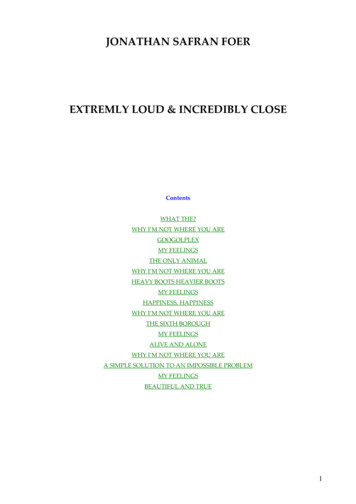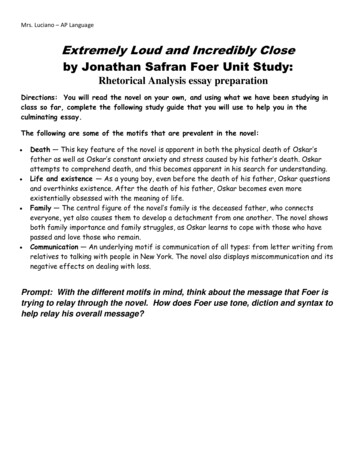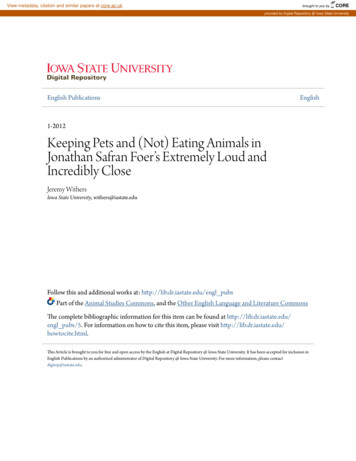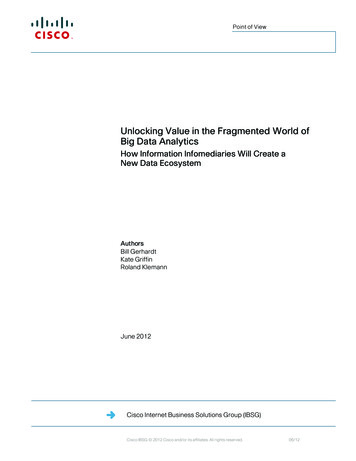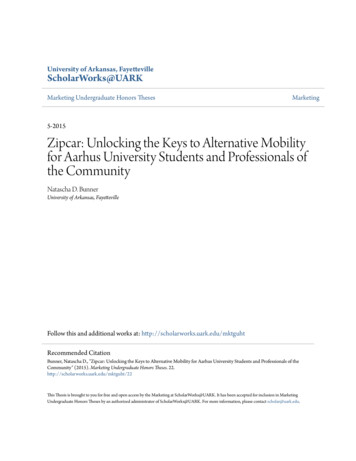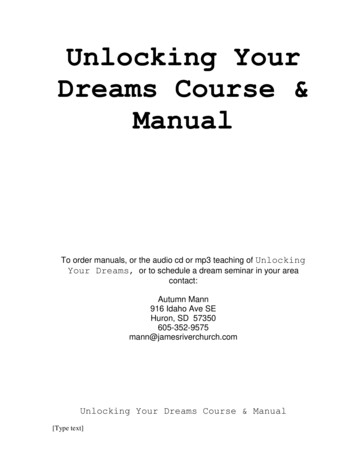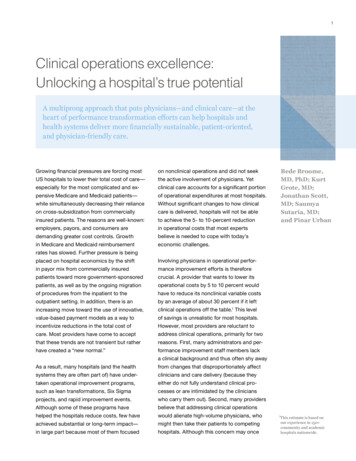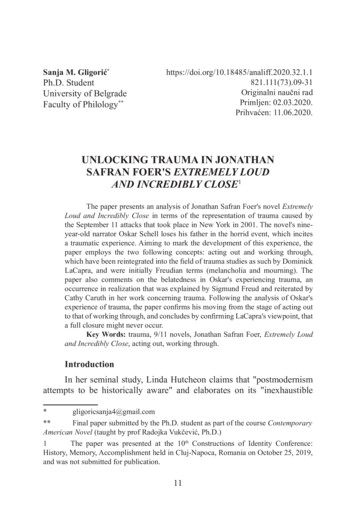
Transcription
Sanja M. Gligorić*1Ph.D. StudentUniversity of BelgradeFaculty of 32.1.1821.111(73).09-31Originalni naučni radPrimljen: 02.03.2020.Prihvaćen: 11.06.2020.UNLOCKING TRAUMA IN JONATHANSAFRAN FOER'S EXTREMELY LOUDAND INCREDIBLY CLOSE13The paper presents an analysis of Jonathan Safran Foer's novel ExtremelyLoud and Incredibly Close in terms of the representation of trauma caused bythe September 11 attacks that took place in New York in 2001. The novel's nineyear-old narrator Oskar Schell loses his father in the horrid event, which incitesa traumatic experience. Aiming to mark the development of this experience, thepaper employs the two following concepts: acting out and working through,which have been reintegrated into the field of trauma studies as such by DominickLaCapra, and were initially Freudian terms (melancholia and mourning). Thepaper also comments on the belatedness in Oskar's experiencing trauma, anoccurrence in realization that was explained by Sigmund Freud and reiterated byCathy Caruth in her work concerning trauma. Following the analysis of Oskar'sexperience of trauma, the paper confirms his moving from the stage of acting outto that of working through, and concludes by confirming LaCapra's viewpoint, thata full closure might never occur.Key Words: trauma, 9/11 novels, Jonathan Safran Foer, Extremely Loudand Incredibly Close, acting out, working through.IntroductionIn her seminal study, Linda Hutcheon claims that "postmodernismattempts to be historically aware" and elaborates on its "inexhaustible*gligoricsanja4@gmail.com**Final paper submitted by the Ph.D. student as part of the course ContemporaryAmerican Novel (taught by prof Radojka Vukčević, Ph.D.)1The paper was presented at the 10th Constructions of Identity Conference:History, Memory, Accomplishment held in Cluj-Napoca, Romania on October 25, 2019,and was not submitted for publication.11
Sanja Gligorićhistorical and social curiosity" (1988: 30). Malcolm Bradbury, too, assertsthis standpoint by claiming that American fiction from 1960 and onwardshas been "particularly obsessed with its own past – literary, social, andhistorical" (1983: 186). Jonathan Safran Foer's Extremely Loud andIncredibly Close, regarded as a work of postmodernist fiction, incorporatesa steady awareness of American history by using points in time at whichtragic events took place to represent trauma, as experienced by the novel'sprotagonists – Oskar Schell and his paternal grandparents.Extremely Loud and Incredibly Close deals with the aftermath of theterrorist attacks which took place in New York on September 11, 2001,during which architectural sites came to be demolished, "together with awhole (Western) value-system and a world order" (Baudrillard, 2003: 38).According to Irene Kacandes, "being able to move from this threat [theone caused by trauma] to the self involves in part accepting the fact thatwhat seemed impossible did actually happen by telling a narrative aboutit and feeling the appropriate affect for such an occurrence" (2003: 171),which is precisely what Foer does in this book. The novel's nine-yearold protagonist Oskar Schell loses his father during that horrendous event,which becomes a traumatic experience for him.Foer's characterization and representation of trauma is such thata set of corresponding concepts from the field of trauma theory can beused to discuss what happens to persons witnessing horrendous events,which cause trauma. In Freudian terms, as restored into trauma studies byDominick LaCapra, reaction to traumatic events is two-fold : the witnessesand victims express the states of 'acting out' or melancholia and 'workingthrough' or mourning, a dichotomy that applies to memory, which "hasbecome the default theoretical groundwork for working with trauma inliterature" (Uytterschout and Versluys, 2008: 216). Additionally, in herwork concerning trauma, Cathy Caruth discusses the "belatedness" of suchan experience, an idea she draws from Sigmund Freud's concept of latency(1996: 17).The mentioned theoretical concepts will be applied to the way thenarrator Oskar experiences the September 11 attacks on the Twin Towers inNew York in the aim of providing an analysis of how trauma is representedin Extremely Loud and Incredibly Close, and whether or not it is possiblefor Oskar to fully recuperate from the mentioned tragic event.12
UNLOCKING TRAUMA IN JONATHAN SAFRAN FOER’S EXTREMELY LOUD .Trauma TheoryPsychological trauma has become an essential issue that has beenelaborated on in literary works, as well as in works of popular culture,all of which aim to discuss the shocking moments of witnessing acts ofterrorist power and their aftermath. As Baudrillard states regarding theomnipresence of these events,Terrorism, like viruses, is everywhere. There is a globalperfusion of terrorism, which accompanies any system ofdomination as though it were its shadow, ready to activateitself anywhere, like a double agent. We can no longer draw ademarcation line around it. It is at the very heart of this culturethat combats it (2003: 10).The increasing occurrence of these events has perpetuatedindividuals' facing their vulnerability when attempting to come to termswith such horrendous occurrences, causing them to experience trauma,which in itself represents "an overwhelming experience of sudden orcatastrophic events in which the response to the event occurs in the oftendelayed, uncontrolled repetitive appearance of hallucinations and otherintrusive phenomena" (Caruth, 1996: 11). The overwhelming aftermath ofwitnessing these events is that they "produce profound and lasting changesin psychological arousal, emotion, cognition, and memory" (Herman,1997: 34), and it is the violence that resides at the epicenter of such attacksthat makes it impossible for the person witnessing the event to register itin its totality and fit it into "existing referential frameworks" (Uytterschoutand Versluys, 2008: 217).Although Herman points out that, "no two people have identicalreactions, even at the same event" (1997: 58), Caruth states that individualssurviving trauma do go through a similar process, and goes on to discussFreud's analysis presented in his work concerning the Jewish past titledMoses and Monotheism, whose confrontation with trauma she considersto be "deeply tied to our own historical realities" (1996: 12), and in whichFreud defines the term latency relating to the fact that events that areoverwhelming in nature are suppressed after they take place unexpectedly,which she considers to explain "the belatedness of historical experience"(1996: 17) stating that,13
Sanja GligorićThe experience of trauma, the fact of latency, would thusseem to consist, not in the forgetting of a reality that can hencenever be fully known, but in an inherent latency within theexperience itself. The historical power of the trauma is not justthat the experience is repeated after its forgetting, but that it is onlyin and through its inherent forgetting that it is first experienced atall (Caruth, 1996: 17).What Caruth is aiming at is precisely the state of any bystander ofsuch tragic events, who is not able to fully grasp what he or she is infact experiencing. LaCapra shares Caruth's opinion about the belatednessin realization, claiming that "trauma is a disruptive experience thatdisarticulates the self and creates holes in existence", which "has belatedeffects that are controlled only with difficulty" and it might be true thatsuch outcomes are "perhaps never fully mastered" (2001: 41).When LaCapra reintegrated the Freudian dichotomy consisting ofmelancholia and mourning, he elaborated on the distinction using thefollowing two concepts: acting out and working through, whereby theformer is defined as follows:In post-traumatic acting out ( ) one is haunted or possessedby the past and performatively caught up in the compulsiverepetition of traumatic scenes-scenes in which the past returns andthe future is blocked or fatalistically caught up in a melancholicfeedback loop. In acting out, tenses implode, and it is as if onewere back there in the past reliving the traumatic scene. Anyduality (or double inscription) of time (past and present or future)is experientially collapsed or productive only of aporias anddouble binds. In this sense, the aporia and the double bind mightbe seen as marking a trauma that has not been worked through(2001: 21).By discussing the state of traumatized victims being trapped in amelancholic loop, LaCapra is referring to their inability to let go of thepast, for they become haunted by the event, which blurs the line betweenpresent and past and persist in repeating what had happened, i.e. memoriesof the past resurface and victims become trapped in reliving the pastunconsciously. Thus, not only does the experience of traumatic events occur14
UNLOCKING TRAUMA IN JONATHAN SAFRAN FOER’S EXTREMELY LOUD .with belated effect, but also in a manner that is "highly fragmentary" andin no way presented as a coherent narrative, i.e. in the form of nightmaresand flashbacks (Uytterschout and Versluys, 2008: 217) pertaining to theconstellation of symptoms which the American Psychiatric Associationties to the Post Traumatic Stress Disorder, or PTSD; some other symptomsassociated with trauma are the following: "increased rates of MajorDepressive Disorder, Panic Disorder, Obsessive-Compulsive Disorder,Generalized Anxiety Disorder, Social Phobia", etc. and "these disorderscan either precede, follow, or emerge concurrently with the onset ofPosttraumatic Stress Disorder" (Levers, 2012: 9). Victims of such eventscan often not consciously leave the stage of acting out, but keep relivingthe trauma, and can experience additional symptoms resulting in that they"take longer to fall asleep, are more sensitive to noise, and awaken morefrequently during the night" (Herman, 1997: 36). According to Levers,victims responding to the event during this stage of trauma share thefollowing symptoms: "intense fear, helplessness, or horror", "persistentre-experiencing of the traumatic events", and "the disturbance must causeclinically significant distress or impairment in social, occupational, orother important areas of functioning" (2012: 9).On the other hand, LaCapra defines the other stage of trauma,working through, in the following manner:Working through is an articulatory practice: to the extentone works through trauma (as well as transferential relations ingeneral), one is able to distinguish between past and present andto recall in memory that something happened to one (or one'speople) back then while realizing that one is living here and nowwith openings to the future. This does not imply either that thereis a pure opposition between past and present or that acting outwhether for the traumatized or for those empathetically relating tothem-can be fully transcended toward a state of closure or full egoidentity. But it does mean that processes of working through maycounteract the force of acting out and the repetition compulsion(2001: 22).While pointing out that the two stages counteract, LaCapra alsopoints out that it is not a rule for working through to follow immediately15
Sanja Gligorićafter the stage of acting out (2001: 22). However, the stage of workingthrough demands of the sufferer of trauma to begin grasping the reality ofthe situation and coming to terms with what had happened, whereby heor she moves from the state of melancholia to that of mourning, and thusbegins rising above the traumatic experience.Oskar's Experience of Trauma : Acting OutThe nine-year-old narrator, Oskar Schell, is both an ordinary boyand a very complex and intelligent character. The latter is visible in theway he enjoys reading literature concerning the field of physics (StephenHawking's A Brief History of Time), his love of French language, theworldly knowledge he possesses at such an early age, like calling himselfa pacifist while "most people [his] age don't know what that means" (Foer,2018: 2), as well as in the pristine figurative language that he employs inabundance. Therefore, when Oskar mentions being sad due to what he hasgone through, he uses the phrase "wearing heavy boots" (Foer, 2018: 2),whereas when he is happy, he says that it makes him "feel like one hundreddollars" (Foer, 2018: 7). The date of 9/11 becomes "the worst day" (Foer,2018: 11), and many more examples follow.It becomes clear at the very beginning of the novel that Oskar hasexperienced something magnanimously upsetting, which has created inhim the need to find flight from it, which he cannot manage to do, for thereis a certain heaviness wearing him back down. At one point he says: "thereare so many times when you need to make a quick escape, but humansdon't have their own wings, or not yet, anyway", after which he says thathe is interested in taking up jujitsu classes "for obvious reasons" (Foer,2018: 2), that being self-defense. The former statement in fact relates tohis way of thinking about his Dad's death, which is something elaboratedon later when Oskar mentions his following idea:The fascinating thing was that I read in National Geographicthat there are more people alive now than have died in all ofhuman history. In other words, if everyone wanted to play Hamletat once, they couldn't because there aren’t enough skulls!So what about skyscrapers for dead people that were builtdown? They could be underneath the skyscrapers for living people16
UNLOCKING TRAUMA IN JONATHAN SAFRAN FOER’S EXTREMELY LOUD .that are built up. You could bury people one hundred floors down,and a whole dead world could be underneath the living one.Sometimes I think it would be weird if there were a skyscraperthat moved up and down while its elevator stayed in place. So ifyou wanted to go to the ninety-fifth floor, you'd just press the 95button and the ninety-fifth floor would come to you. Also, thatcould be extremely useful, because if you’re on the ninety-fifthfloor, and a plane hits below you, the building could take you tothe ground, and everyone could be safe (Foer, 2018: 3).Boys his age do not normally concern themselves with the toil a deathcan bring, nor do they obsess with ways a tragedy that was as grave as the9/11 attacks could be prevented – it is precisely the experience of losinghis father, coupled with the fact that on the day of his death Thomas Shellleft five messages on the answering machine to which Oskar could notanswer due to the excessive amount of shock, that make the nine-year-oldnarrator experience trauma, which is why he soon afterwards "embodiesmost of the symptoms of trauma, those normally attributed to adults aswell as those specific to children" (Uytterschout and Versluys, 2008: 229),an instance of which is his abovementioned string of thoughts and theway he "desperately clings to the memory of his father" (Uytterschoutand Versluys, 2008: 232). One night, following an episode of fear, Oskarenters his Dad's closet hesitantly holding "the doorknob for a while before[he] turned it" (Foer, 2018: 36). The very realization of the fact that "eventhough Dad's coffin was empty" due to the fact that the body was neverretrieved after the tragedy, "his closet was full", "and even after more thana year, it still smelled like shaving" (Foer, 2018: 36) brings Oskar in a stateof fiercely attempting "to remember every tiny detail" about his father, for"what the boy wants above all is to piece together an image of his father"(Uytterschout and Versluys, 2008: 232), which is why the narrative in thepresent becomes intertwined with his memories of his father,I touched all of his white T-shirts. I touched his fancy watchthat he never wore and the extra laces for his sneakers that wouldnever run around the reservoir again. I put my hands into thepockets of all his jackets (I found a receipt for a cab, a wrapperfrom a miniature Krackle, and the business card of a diamond17
Sanja Gligorićsupplier). I put my feat into his slippers. I looked at myself in hismetal shoehorn. The average person falls asleep in seven minutes,but I couldn't sleep, not after hours, and it made my boots lighterto be around his things, and to touch stuff that he had touched, andto make the hangers hang a little straighter, even though I knew itdidn't matter (Foer, 2018: 36-37).During the stage of acting out, as defined by LaCapra, and visiblehere in the way Oskar cannot get rid of the image of his father, but keepsreturning to the physical remnants of his now gone presence, i.e. hispossessions, the narrator manifests further symptoms characteristic oftrauma victims, such as taking longer to fall asleep, awakening frequentlyat nighttime (Herman, 1997: 36), or not being able to seek slumber at all.Moreover, Oskar expresses a myriad of symptoms which, according toLevers, pertain to the behaviour of victims responding to traumatic events.He senses "intense fear" of which he is acutely aware, he is caught in aconstant "re-experiencing of the traumatic events" (2012: 9):Even after a year, I still had an extremely difficult time doingcertain things, like taking showers, for some reason, and gettinginto elevators, obviously. There was a lot of stuff that made mepanicky, like suspension bridges, germs, airplanes, fireworks,Arab people on the subway (even though I'm not a racist), Arabpeople in restaurants and coffee shops and other public spaces,scaffolding, sewers and subway grates, bags without owners,shoes, people with mustaches, smoke, knots, tall buildings,turbans. A lot of the time I’d get that feeling like I was in themiddle of a huge black ocean, or in deep space, but not in thefascinating way. It's just that everything was incredibly far awayfrom me. It was worst at night. I started inventing things (Foer,2018: 36).His state of fear relates to what Kacandes terms the breach betweena pre-traumatic and post-traumatic worldview (2003: 180) and it showsthat "traumatic events are extraordinary, not because they occur rarely, butrather because they overwhelm the ordinary human adaptations to life"(Herman, 1997: 33). Moreover, "exposure to certain kinds of events maytransform one's view of the world, and, consequently, one simply cannot18
UNLOCKING TRAUMA IN JONATHAN SAFRAN FOER’S EXTREMELY LOUD .be in the world in the same way as prior to exposure (Kacandes, 2003:171), which is precisely what Oskar is going through seen from the factthat the circle of 'frightening' things has enlarged to a great extent, evenincluding an obsessive "lookout to avert lurking dangers" (Uytterschoutand Versluys, 2008: 230), such as entering the Empire State Building, orany skyscraper in general.Oskar's response to the fact that the tragic event took place is twofold, for he is "at the same time able and unable to share what he is goingthrough" and thus articulate what happened, pointing towards his "selectiveinability to testify to his (traumatic) experiences" (Uytterschout andVersluys, 2008: 231), which represents an instance of what Brison (1999)elaborates on as being able to say what happened but failing to registerthe full impact of the occurrence in question. Such state of suppressingfeelings leads to "sudden outbursts of anger towards people" (Uytterschoutand Versluys, 2008: 231), mostly those that are closest to him: his motherand Grandmother. At one point in the novel, Oskar shows strong feelingsof animosity towards his mother claiming (without wanting to) that if hehad any say in the matter, he'd rather have her die than his father,"Promise me you won't fall in love." "Why would you askme to promise that?" "Either promise me you'll never fall in loveagain, or I'm going to stop loving you." "You're not being fair.""I don't have to be fair! I'm your son!" She let out an enormousbreath and said, "You remind me so much of Dad." And then Isaid something that I wasn't planning on saying, and didn’t evenwant to say. As it came out of my mouth, I was ashamed that itwas mixed with any of Dad's cells that I might have inhaled whenwe went to visit Ground Zero. "If I could have chosen, I wouldhave chosen you!"She looked at me for a second, then stood up and walkedout of the room. I wish she'd slammed the door, but she didn't.She closed it carefully, like she always did. I could hear that shedidn’t walk away (Foer, 2018: 171).The verbal exchange is followed up by Oskar asking his motherfor forgiveness, and her claiming that she was never mad at him, buthurt (Foer, 2018: 172). This is when Oskar is stuck somewhere between19
Sanja Gligorić"feeling and not feeling" establishing a state of mind which is "a 'mixture'of melancholia and mourning" (Uytterschout and Versluys, 2008: 231).Oskar's Working Through His TraumaAccording to the philosopher Susan Brison, "at least in the case of asingle traumatic event, the event is experienced at the time and rememberedfrom that time, although the full emotional impact of the trauma takestime to absorb and work through" (1999: 210). In order to mourn andmove away from the belatedness of such a realization, as voiced by bothLaCapra (2001: 41) and Caruth (1996: 17) and present in Oskar's stage ofacting out, Oskar has to actively realize that he has lost his father in theSeptember 11 attacks, thereby reaching the stage of working through.What serves as an aid to this stage is the form of the detective tale,which the narrative initially takes. One day, upon rummaging among hisfather's things, Oskar stumbles upon an envelope containing an unknownand strange-looking key, "fatter and shorter than a normal key" (Foer,2018: 37). Upon realizing that his attempts to match it with a lock withinthe apartment are futile, Oskar embarks upon a quest to find the properlock somewhere in the city of New York, the total number of which heapproximates to be "about 162 million locks, which is a crevasse-load oflocks" (Foer, 2018: 41). Then he decides to visit every person whose lastname is Black and attempt to find the lock in question.Therefore, there seems to be a puzzle to be resolved, clues tobe understood and an answer to be found. However, as it happens inpostmodernist works, the purpose of the detective tale resides in somethingentirely different from resolving a mystery. In his famous essay "TheLiterature of Exhaustion" (1967) John Barth points out, and confirms laterin "The Literature of Replenishment" (1980), that modernism and realismhave exhausted the form of the novel and that it "could be revivified bystitching together the amputated limbs and digits in new permutations",i.e. by using pastiche, which "arises from the frustration that everythinghas been done before" and represents "a kind of permutation, a shuffling ofgeneric and grammatical tics" (Lewis, 2001: 125-126). Lewis also stressesthat this particular drive to bring the novel back to life by using pasticheis the reason that contemporary novels "borrow the clothes of differentforms", which, in the case of Foer's Extremely Loud and Incredibly20
UNLOCKING TRAUMA IN JONATHAN SAFRAN FOER’S EXTREMELY LOUD .Close, has to do with his use of the form of the detective tale, wherebyhis "impulse behind this cross-dressing is more spasmodic than parodic";authors of the postmodernist genre also love employing "the pursuit ofclues" characteristic of the detective tale due to the fact that "it so closelyparallels the hunt for textual meaning by the reader" (Lewis, 2001: 126).Foer does not employ the dress of the detective tale for the sole purpose ofhaunting for meaning, which surely is one of its functions, but he adds afurther one: that of serving as a means of enabling the novel's protagonistOskar to find a way to move towards "unlocking his trauma" caused byhis father's death, which is, thus, "on a symbolic level" (Uytterschout andVersluys, 2008: 230) being tentatively aided by his quest to find the rightlock fitting the key he found among his father's things.The role of the quest is to help Oskar communicate and verbalizewhat he has gone through, because it "helps him speak the unspeakable"(Herman, 1997: 2), which he does, and to complete strangers that hemeets upon embarking on it. Oskar does not confide in his mother, orGrandmother and is not willing to share his view of the traumatic eventwith them (Uytterschout and Versluys, 2008: 231), which is why it can bestated that the symbolic aspect of the quest is located in the fact that thereis a door to be unlocked, just not a physical NY front door, but a doorleading to Oskar unlocking his trauma and beginning to realize the tragicloss of his father, and thus embarking on working through his pain. AsKacandes points out, numerous critics, academics and psychotherapists"emphasize the critical act of creating narratives about what has happenedin order to 'absorb and work through the trauma'" (2003: 171), which mightbe the case with the novel's protagonist, who embarks on a seeminglydetective narrative, and through that quest manages to find a way to "recallin memory that something happened" to him, and thereby "counteract theforce of acting out" (LaCapra, 2001: 22). On one such occasion, Oskardecides to visit Abe Black in Coney Island travelling in a cab, after whichAbe offers to give him a ride to the next 'Black', and they embark upon thefollowing conversation:While we were in the car I told him all about how I wasgoing to meet everyone in New York with the last name Black. Hesaid, "I can relate, in my own way, because I had a dog run away21
Sanja Gligorićonce. She was the best dog in the world. I couldn't have loved hermore or treated her better. She didn't want to run away. She justgot confused, and followed one thing and then another." "But mydad didn't run away," I said. "He was killed in a terrorist attack(Foer, 2018: 149).Briefly before this exchange, Oskar mused about driving in a rollercoaster and feeling "intense fear" (Levers, 2012: 9), in itself a symptom oftrauma and acting out,Obviously I'm incredibly panicky about roller coasters, butAbe convinced me to ride one with him. ( ) In my head, I triedto calculate all of the forces that kept the car on the tracks and mein the car. There was gravity, obviously. And centrifugal force.And momentum. And the friction between wheels and the tracks.And wind resistance, I think, or something (Foer, 2018: 147).Regardless of his fear, Oskar does become able to verbalize, to talkto the stranger, and put into "articulatory practice" (LaCapra, 2001: 22)what he is working through: the act of accepting that his father has died,the source of his trauma, by pronouncing the sentence "he was killed in aterrorist attack" (Foer, 2018: 149).Regardless of the fact that Oskar shies away from those closest tohim but turns to the ones who are unknown to him, his family is alwaysthere for him. At first, that might not be obvious, for who would in theirright mind let their child wander around an urban landscape as vast as NewYork without asking any questions? It is only at page 291 that it is revealedthat his mother was in on it the whole time,It didn’t make any sense.Why hadn't Mom said anything?Or done anything?Or cared at all?And then, all of a sudden, it made perfect sense.All of a sudden I understood why, when Mom asked whereI was going, and I said "Out," she didn't ask any more questions.She didn't have to, because she knew (Foer, 2018: 291).22
UNLOCKING TRAUMA IN JONATHAN SAFRAN FOER’S EXTREMELY LOUD .That is precisely why Mr. Black, the old neighbour, behaved as hedid when Oskar knocked upon his door, he "was part of it" and his Momprobably told him to go around with Oskar and provide help and assistanceduring the quest concerning the key found in the blue vase (Foer, 2018:291). It is her who remains silent in order to help her son because she isaware that he has to go through this stage in order to prepare himself forthe possibility of recovering from the trauma he had experienced.At this point, upon realizing that he did not partake in a detectivequest, but something entirely different, Oskar talks to his mother andshares his feelings, which is when he "becomes more of a mourner", asopposed to "the beginning [when] Oskar had more in him of a melancholic"(Uytterschout and Versluys, 2008: 233), and it is the stage of mourning orworking through that helps him realize what had happened in the past, andbe aware that he is living in the present moment,Slowly but certainly, the process of mourning enablestraumatized people to develop a narrative memory of the traumaticevent. It allows them to remember what happened to them at acertain point in the past, while at the same time realizing that theyare living now (Uytterschout and Versluys, 2008: 218).Oskar embarked upon the quest in order to get closer to his fatheragain, but it ended up bringing him closer to his mother (Uytterschout andVersluys, 2008: 234). However, the final pages of the novel make up aflipbook showing pictures of a falling body that were found online, and byreversing the initial order of these pictures, an image of a body returningback into the building is created, a body that is returning to safety. Bydoing so Oskar shows again a grave desire to change the past and save hisfather's life, which relates to an idea explained by LaCapra - that victimsand those traumatized might never be able to become "fully transcendedtoward a state of closure" (LaCapra, 2001: 22). It is precisely these finalpages that John Updike (2005) mentions in a New Yorker article when hediscusses the novel's "hyperactive visual surface" and stresses that:The book's graphic embellishments reach a climax in the lastpages, when the flip-the-pages device present in some children'sbooks answers Oskar's yearning that everything be run backward23
Sanja Gligorić– a fall is turned into an ascent. It is one of the most curious happyendings ever contrived, and unexpectedly moving (para. 10).This climax might indicate that Oskar will never be able t
11 Sanja M. Gligorić*1 Ph.D. Student University of Belgrade Faculty of Philology**2 UNLOCKING TRAUMA IN JONATHAN SAFRAN FOER'S EXTREMELY LOUD AND INCREDIBLY CLOSE13 The paper presents an analysis of Jonathan Safran Foer's novel Extremely Loud and Incredibly Close in terms of the representation
